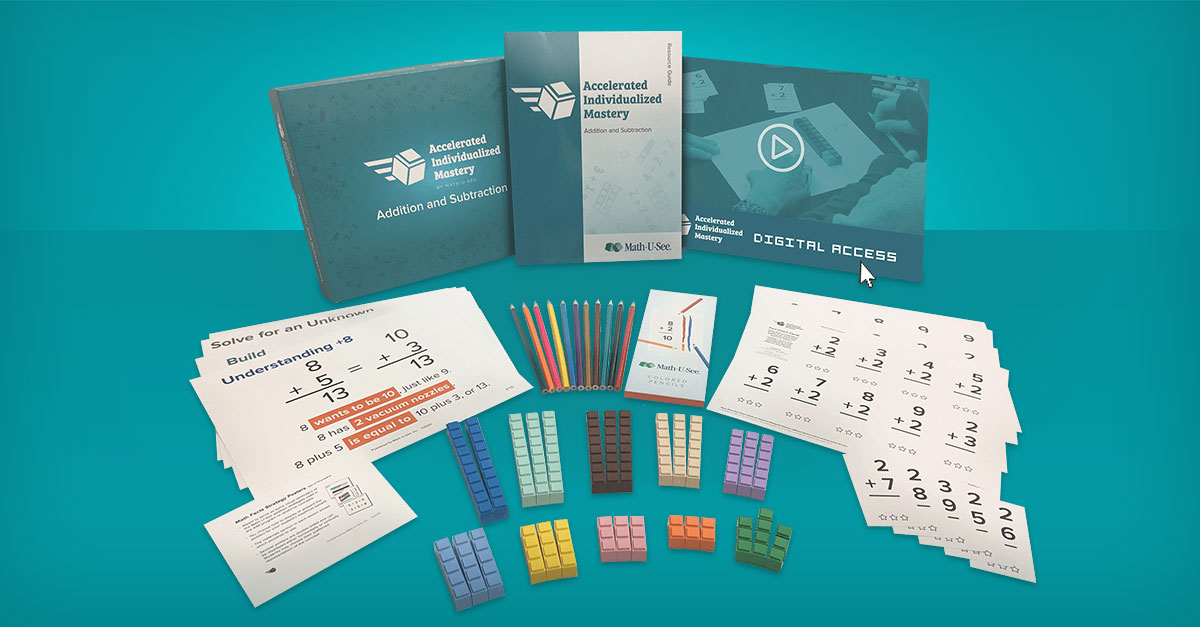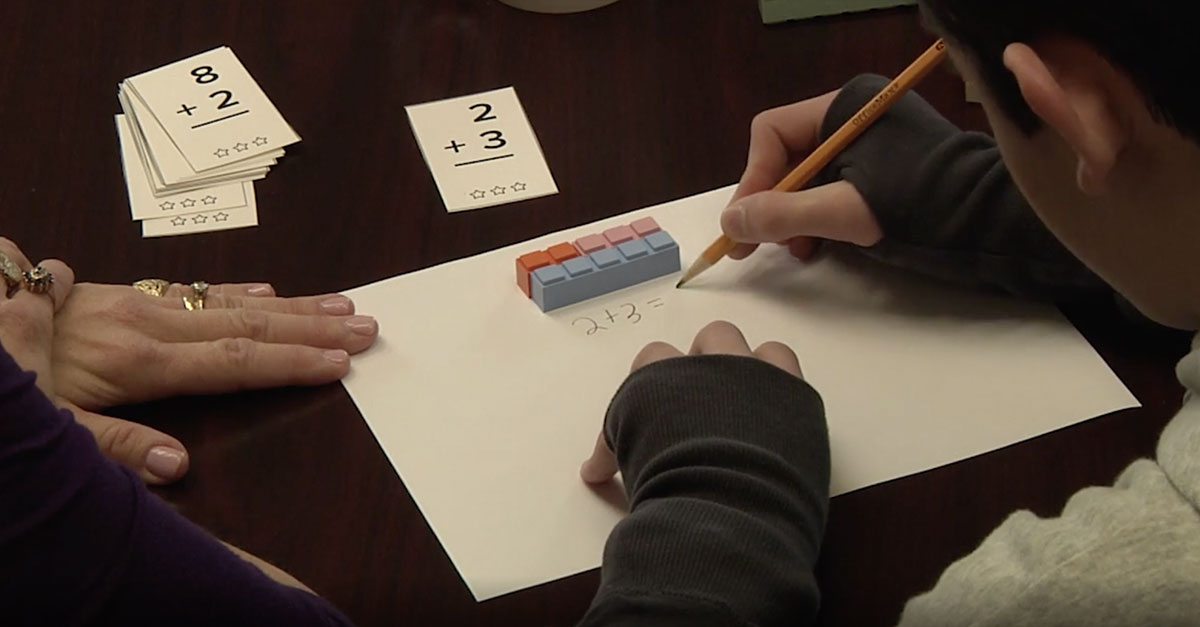
At Math-U-See, we often see students who struggle mathematically. The roots of those struggles are sometimes a mystery to educators and parents alike. Over the past couple of years, I have conferred with over one hundred parents who have said things like, “Well, she is just not mathematically inclined,” or “He does not have a math brain.” or, even more frequently, “He/she has ____ (insert a disability label here) which makes it impossible for them to memorize facts.” In the world of “been there, done that,” I have a blue ribbon for doing or saying all those things.
Making Math Doable for Our Children
What I would like to ask of you is that, for the next few minutes, let’s set aside those suppositions about our students. Let’s ask ourselves instead, “What if there were a way to make mathematics more doable for my child?” I don’t know about you, but personally, as a parent, I would walk through fire to help my children be successful.
Over the past couple of years, I have had the privilege of having dozens of conversations with parents who have said these things about their children. To be honest, my parents would have said those things about ME. You see, I HATED math, and dreaded every encounter with it. It was not until I realized I wanted something different for my children and found my way to Math-U-See that I finally learned why I disliked math so much. My mathematical foundations were weak, and because of that, more complex mathematics (insert the word “algebra” here) was a mystery to me.
Is AIM for Addition and Subtraction Right For Your Student?
Today I want to talk about whether AIM for Addition and Subtraction is the right choice for your student. If you are considering AIM (Accelerated Individualized Mastery) for Addition and Subtraction, you may be asking yourself “Why would I need to go so far backward with an older student?” You may even be muttering to yourself, “Something as simple as addition and subtraction mastery cannot be the root cause of my student’s struggle!”
Are you the parent who has used flashcards endlessly, purchased more than one set of physical or electronic math “games,” provided your child with endless sheets of timed tests, all in an effort to get them to commit facts to memory? If so, you are probably saying, “What I have done has not worked – so why in the world would THIS work?!?”
Early in my tenure at Math-U-See, a colleague said to me “Gretchen, flashcards do not teach – they only help you become more proficient at what you already know.” Wow. I had never even thought of that. I was the t-shirt wearing, poster-bearing personification of “drill and kill” with my own children. They memorized their facts, but only because I was relentless and annoying! What if there were a way to do it more easily??
Enter the AIM for Addition and Subtraction program. AIM is a tremendous collaboration between the staff of Math-U-See and those parents who thought their children would never memorize the facts. We are grateful for their collaboration with us in developing a methodology that really does work – regardless of the lack of success YOU, as the frustrated parent, have had in the past.
Why is AIM for Addition and Subtraction Successful?
Why is the AIM process successful, when so many other methods that you have probably tried, have not been?
First and foremost, our goal is to remove the stigma of not having your facts memorized, and the resulting anxiety that accompanies it. Children really desire to please us, their parents and teachers, and in that desire, they may go to extraordinary lengths to imply they know something they do not. Stress is introduced into the equation. And the more often you encounter stress, the more anxious you become.
“How then, Gretchen,” you say, “can memorizing addition and subtraction facts help my teenager struggling with Algebra?” We all come to the table with a finite amount of attention and energy to dedicate to solving a math problem, whether it is simple computation or something more complex like algebra. Granted, the older we are, the easier it is (theoretically) for us to stay engaged to solve a problem. But here is the challenge – if you are stretching just to recall your basic computational facts, it is even harder for you to stay engaged with that algebra problem to its conclusion. Still skeptical? Think of it this way: If I handed you a paragraph to read, and you had to sound out every word in that paragraph to read it, how would your comprehension be? Not great, right? THAT is what happens when we don’t have those facts committed to memory.
In the fruition of this collaboration with parents, we have taken the principles of math fact memorization and stripped them of their age associations. We have further added current learning theory principles to help a student begin to show us how they are committing those facts to memory. And the most important thing of all is that we have given students permission to admit what they do not know yet, identified the associated anxiety with the memorization process, and created an affirmative experience where they can experience success.
The question I would like YOU to ask is, “Why would you not take a small investment of time and money to help your child be more mathematically successful?” In consulting with parents of teenagers, I often ask them what they think their student wants to do after their high school years. Students often have ambitions of college or skilled trades that by necessity will involve mathematical competence. Investing in the process of AIM for Addition and Subtraction allows a student to keep those potential pathways wide open. And isn’t a bright future what we ALL want for our children? Take the first step on the path to re-ordering mathematical success in your household.




We received AIM early last week and have been working through the lessons. My family is new to MUS but we have been using Spelling You See for a few years. This week was the first time my daughter has said “Mom! Math is fun!” Thank you for bringing her the joy of learning math.
Jamie — I never thought I would EVER utter those words. But how gratifying it is to see a student who has struggled in the past, feel that sense of achievement. Welcome to Demme Learning! We will look forward to walking this path with you!
Do you have AIM for Multiplication?
Michelle, it is in development, but it will take time to complete that process. We have been working with families in close collaboration for 5 years. You don’t have to wait for AIM for Multiplication to come to market to have success. Reach out to our placement specialists at Math U See. Sue Wachter, Michael Sas, or myself, would be happy to help you have success now.
Good news! 🙂
https://demmelearning.com/new-math-u-see-product-aim-multiplication/
Will there be AIM for the multiplication/division facts as well? I have students who struggle with all of the facts.
Good news! 🙂
https://demmelearning.com/new-math-u-see-product-aim-multiplication/
Dylan, just in case you do not see what I replied to Michelle, who asked a very similar question, I will repost my answer here: AIM for Multiplication is in development, but it will take time to complete that process. We have been working with families in close collaboration for 5 years. You don’t have to wait for AIM for Multiplication to come to market to have success. Reach out to our placement specialists at Math U See. Sue Wachter, Michael Sas, or myself, would be happy to help you have success now.
I think this will help two of my children. Do I need to purchase 2 separate boxes, or do they share the materials in one? I didn’t know if there were consumable worksheets in the box.
Noelle, my apologies. I have been away. You should find one AIM for Addition and Subtraction sufficient. However, some parents have suggested to us that they would like an additional set of Math U See pencils if more than one student is working simultaneously. That will be your call. You can order the pencils separately. One set will come with the program.
I have two questions!
Can this be used along with Alpha or can it be used as a complete program all by its self?
Also, can I use this for an older student and wait on Gamma Program?
Megan, AIM for Addition and Subtraction is designed as an intervention for an older student who has not successfully mastered their facts. The Alpha program is designed for students who are ready for their first level of mastery. If you mean can you use them concurrently, with different age students, then the answer would, of course, be yes. We have used the AIM Program for students ages 8-18. With an older student, we recommend that you suspend other mathematics programs while implementing the AIM program. Of course, should you have specific questions about your family’s situation we would always recommend you call us at Math U See.
Will this work for a kiddo who is advanced in math overall but seems to mix up addition “finding 10” and subtraction “making 10”? My little one keeps trying to add columns by making 10 but in a harder way … Example
7
4
5
3
_
My little one will add the 7 and 4 to get 11 and then take the 1 from the 11 to make it 10 and then add it to the 5 to make 6 then add in the 3. Makes my little one get the problems wrong bc she forgets what she already added. I have tried to show her to add the numbers that “already make 10 on their own” to “find 10” instead of creating 10. But she can’t seem to grasp the difference. She is in 2nd grade but tests at 3rd grade level … Yet the larger the numbers get and more rows of numbers to add the more she is getting wrong and becoming confused. She genuinely believes she has “made 10” and done the problem correctly 😔
(in 2nd grade but testing at 3rd grade)
Tracy – you ask a very good question, and what you are referring to here may not be just the simple commitment of factual understanding. This seems to be the process that she is struggling with, and I often find that advanced students struggle with a concept they cannot nail easily. I must ask for clarification: Is she weak in her fact recall? If so, that might mean that as she “steps out” of the problem to recall the fact, it is more difficult to remember where she is when she “steps back into” the problem. If she has all of her facts memorized, it may be that she has a misunderstanding of the process. There may be merit in your doing the AIM for Addition and Subtraction pretest, because that would answer the question of fact recall. But I am also happy to have a conversation with you to do a little more in-depth troubleshooting. You are welcome to call or text to 717.524.5692.